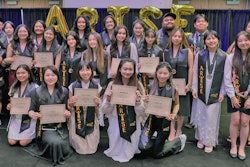Unless political candidates and their operatives more consistently and aggressively mobilize the Asian-American electorate and steer them into voter registration, the impact of this racial group at the polls will remain limited.
That’s the opinion of Dr. Janelle Wong, a University of Maryland professor of American studies and interdisciplinary political scientist.
 Dr. Janelle Wong
Dr. Janelle Wong“It’s a self-fulfilling prophecy and circular issue,” Wong says. “We have to break the cycle of relatively low-propensity voter turnout. But nothing will change if we don’t mobilize more Asian Americans. Mobilization needs to be year ‘round, not just during presidential election years because the turnaround is too short.”
Wong’s comments are in response to a new report by the Center for American Progress that found that in the 2016 U.S. presidential election, only 49 percent of Asian-American voters cast ballots compared to 64 percent of Whites.
The disparity has existed for several decades, according to the report, and shows no signs of fading without targeted intervention.
Nationally, people of Asian descent are expected to make up about 10 percent of eligible U.S. voters by 2036.
The center’s report – which suggests multiple ways to improve Asian-American voter turnout – zeroes in on the fact that only 56 percent of Asians versus 72 percent of Whites are even registered to vote. The report’s findings blame laws around the country that reinforce the gap by not making voter registration easier.
In Georgia, for instance, officials rejected thousands of Asian-American applicants in 2016 because their names didn’t match those with slightly different spellings on other forms of identification – a common occurrence among people, regardless of race, with transliterated names. This practice resulted in Asian Americans being six times more likely than Whites to have their voter registrations delayed or rejected.
he center’s report also states that most political campaigns fail to adequately engage Asian-Americans. It cites a post-2016 election survey showing that only 33 percent of Asians reported being contacted by a partisan or nonpartisan organization regarding the election, compared to 46 percent of Whites.
Contacting voters fuels turnout. Phone banking, for example, boosted by 10 percentage points the turnout of Asian Americans in Southern California.
Wong criticized both major political parties for doing little to mobilize Asian-Americans across the board – except for reinforcing stereotypes.
“We get hammered all the time with simplistic, superficial messages,” she said. “Politicians tell Asian Americans, ‘We care about families, and we care about education.’ Never mind that the ‘forever foreigner’ stereotype constantly comes into play. But Asian Americans have a broader agenda than just immigration and education.”
Wong lists three issues that resonate deeply among Asians: They tend to support the Affordable Care Act, popularly known as Obamacare; they favor environmental protection and subsequently support restrictions on corporations; and many are willing to pay higher taxes in order to provide more social services to people as well as to give the middle class a tax break.
“It’s an understatement to say they’re missing an opportunity,” Wong said of political candidates and their camps.
The center’s report suggests other methods to boost Asian-American voter turnout:
Eliminate language barriers at the polls. Nearly one-third of Asians are limited English proficient, meaning they speak it “less than very well.” A 2016 survey showed that in some ethnic communities, as many as 60 percent of voters prefer language assistance when voting. Cook County in Illinois provided Korean-language ballots ahead of the November 2016 election even though it wasn’t required by the federal Voting Rights Act.
Government and nongovernmental organizations should collect robust, disaggregated data on polling and analysis of Asian Americans. Broadly reporting the opinions and experiences of Asians yields incomplete portraits while complete information provides political campaigns with reliable information in order to better target and serve Asian American voters.
Lawmakers should end discriminatory voter-purging policies. Some states actively remove people from voter rolls due to clerical errors, inaccurate data or if they suspect a person voted in another state. Approximately half the states use a “crosscheck” program that relies on first and last names to generate lists of potential double-voters. Asian Americans with common surnames like Patel and Kim are likely to be wrongly targeted and purged from the voter rolls.
Wong notes the irony of trying to improve mobilization of the Asian American electorate.
“The major parties see who’s registered,” she says. “If a person hasn’t shown engagement, then party officials decide, ‘Let’s not invest in them.’ This year, here we are coming up on congressional elections and the stereotypes are deep. It’s a default the way Asian American issues are framed.”
Because there will be no clear racial majority in the United States by 2043, the center’s report concluded, racial disparities in voter turnout “should not be accepted as the status quo.”
“In the face of a changing population, society must act to ensure that all Americans, no matter their race or ethnicity, can access the most fundamental right in our democracy — the right to vote.”


















